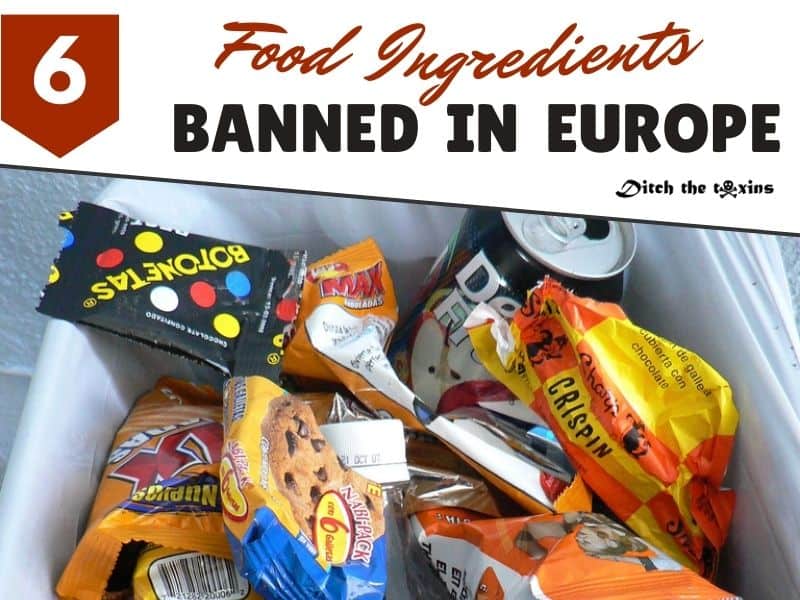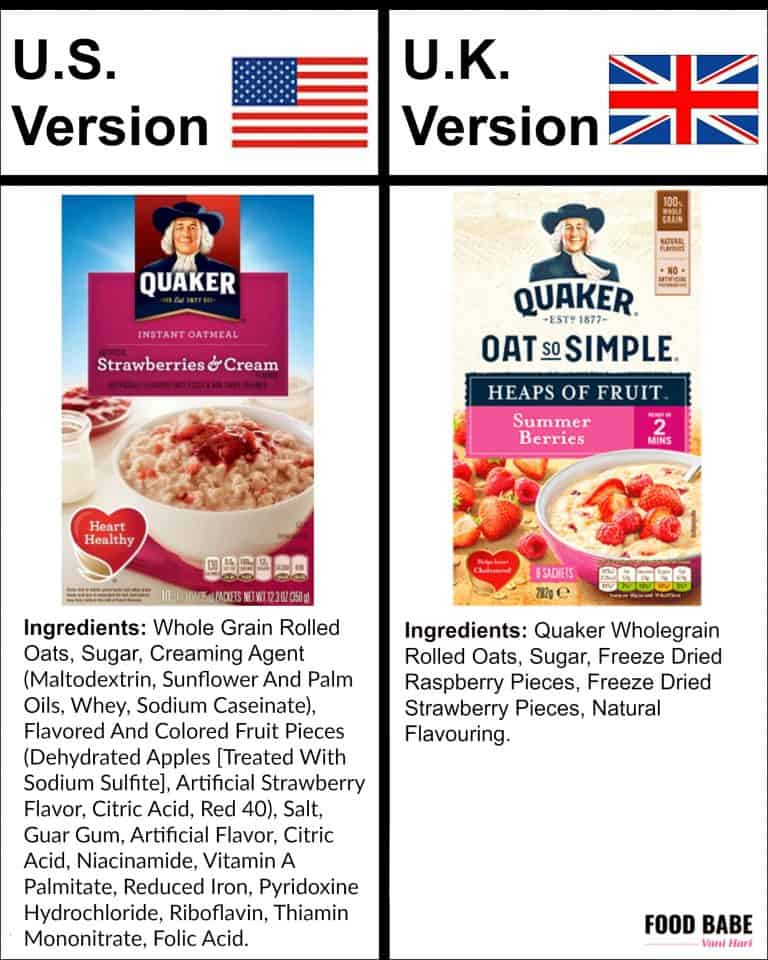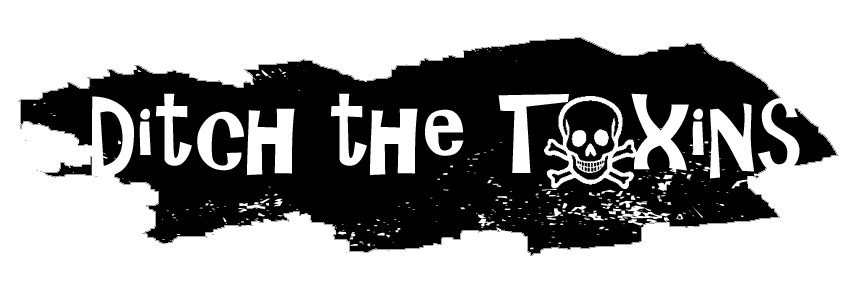We all want to safe nourishing foods. Did you know there are common food ingredients that are banned in Europe but added to food in the United States?! This revelation raises important questions about why these ingredients are still being used and, how it impacts our health and our families. Let’s explore the topic of banned ingredients in Europe, uncovering why these ingredients have been banned and how to avoid them. Join me on this journey to safer, healthier eating for ourselves and our loved ones.
Sadly the following ingredients are very common in the US food supply and you are likely consuming them without realizing it. The bad news: many ingredients are known carcinogens, which means they have the potential to cause cancer. The good news: once you know what these ingredients are you can actively avoid them limiting your risk.

Artificial Food Colors & Dyes
What is it?
- Blue 1, Blue 2, Yellow 5, Yellow 6, Red 40, and Red 3
- They are mass-produced in a lab and frequently derived from petroleum or coal tar.
- Natural vs Artificial Colors
What does it do?
- It makes food brightly colored so people are drawn to it and buy it.
Health Hazards
- In Europe products that contain artificial colors have a mandatory label “may have an adverse effect on activity and attention in children.”
- Artificial Colors are included in the EWG Dirty Dozen Food Ingredients.
- Studies link hyperactivity in children.
- Artificial Colors come with an increased risk for Allergies and Cancers.
- The FDA officially states the reactions CAN occur:
Reactions to color additives are rare. It is possible, but rare, to have an allergic-type reaction to a color additive. For example, FD&C Yellow No. 5 may cause itching and hives in some people. This color additive is widely found in beverages, desserts, processed vegetables, drugs, makeup, and other products. FDA requires all products containing FD&C Yellow No. 5 to identify it on their labels so that consumers who are sensitive to the dye can avoid it. On medicine labels, this certified color additive is also identified by its uncertified name, “tartrazine.”
9 Solid Reasons to Ditch Artificial Food Colors
Where its found
The obvious brightly colored foods like
- Candy
- Cakes
- Fruit Snacks
- Cereal
- Juices and Sports Drinks
More unsuspecting places like
- Condiments like Mustard and Ketchup
- Pickles
- Macaroni and Cheese
- Medicines
- Sport Drinks / Sodas
What should you do?
The good news is that manufactures are starting to listen.
- In 2015 Kraft removed Yellow 5 and Yellow 6 from macaroni and cheese.
- Paprika and Annatto replaced the yellow in everyone’s favorite dinner.
The bad news is that they are still out there. You can avoid them by
- Reading food labels.
- Buying foods that use “natural” food coloring.
Potassium Bromate (brominated flour)
What is it?
- A chemical oxidizing agent used in baking bread
What does it do?
- It makes bread rise more quickly and strengthens the dough.
- It also makes dough fluffier and whiter
Health Hazards
- It’s banned in the EU, Canada, Brazil, and China
- The International Agency on Research for Cancer (IARC) declared it a possible human carcinogen in 1999.
- This ingredient is Included in the EWG Dirty Dozen Food Ingredients.
- California requires a warning label for all products made with potassium Bromate.
Where its found
- Bread
- Baked Goods
- Fast Food buns
- Crackers
What should you do?
- Check ingredient lists for “potassium bromate” and “bromated flour.”
- Use the EWG’s Healthy Living App to find out which products contain Potassium Bromate.
Azodicarbonamide (ADA)
- A chemical additive used as a whitening agent and dough conditioner.
- Commercial bakers have been using this bleaching agent since the 1960s.
- Bread can be made without it. It is not a necessary Ingredient.
- Also known as the yoga mat chemical thanks to Food Babe.
Health Hazards
- Azodicarbonamide has been banned for consumption by the European Union for over a decade.
- India banned it in 2016, and the UK has forbidden it since 1990.
- Linked it to respiratory issues, allergies and asthma by The World Health Organization.
- A maximum allowed level exists for use in flour, bread and rolls.
- Manufactures are starting to listen
Where its found
- Chain restaurants that serve sandwiches and buns.
- 500 common American grocery store and chain restaurant foods.
What should you do?
- Read labels when buying baked goods.
- Use the EWG’s Healthy Living App to find out which products contain ADA.
Brominated vegetable oil (BVO)
- A controversial ingredient banned in Europe but still found in some American drinks
- It is used to prevent ingredients in sodas and soft drinks from separating.
- Most commonly used in citrus flavored sodas and sports drinks.
Health Hazards
- BVO is banned as a food additive in Europe and Japan.
- It is linked to nerve damage, thyroid problems, and behavioral disorders.
- Contains bromine, the element found in brominated flame retardants
- BVO can build up in the body and cause toxic effects. Especially in high amounts over a long period of time.
Where its found
- Citrus Sodas
- Sports Drinks
What you should do
- Avoid drinks that look cloudy or hazy, these usually contain BVO.
5 Appalling Things to Know About Trans Fats
Butylated hydroxyanisole (BHA) & (BHT)
What is it?
- BHA and BHT helps prevent foods from going rancid by helping to stop oxygen from mixing with oils in the food.
Health Hazards
- Both are on the EWG dirty dozen list.
- According to EWG rats fed BHT developed lung and liver tumors.
- California requires a warning label.
- National Toxicology Program classifies BHA as a “reasonably anticipated to be a human carcinogen”.
Where its found
- Chips
- Cereal Packaging
- Packaged & preserved meat products
- Many packaged products
What you should do
- Read Food Labels
Synthetic growth hormones (rBGH and rBST)
What is it?
- Officially called Recombinant Bovine Growth Hormone
- These synthetic hormones are injected into dairy cows to increase milk production.
- Used by the dairy industry in the United States.
- Approved for use in cows by the FDA in 1993.
Health Hazards
- This practice is banned in Europe.
- Dairy cows injected with these hormones suffer from significant health problems. Sick cows are treated with antibiotics which contributes to antibiotic resistance.
- Treated cows often become lame, infertile, and suffer from inflamed and infected udders.
Where its found
- Diary Products.
- Milk
- Cheese
What you should do
- Choose organic, hormone and antibiotic-free milk.
- Look for label “From cows not treated with rBST”
- Only eat cheese or dairy product that you KNOW does not have these synthetic hormones.
How to Avoid Ingredients Banned in Europe
Eat Real Food
Eat foods as close to nature as possible.
Eat LESS of foods that come in a box, can or package and eat MORE
- Fresh Fruits
- Vegetables
- Whole Grains like Rice, Quinoa,
- Legumes or Beans
- Nuts and Seeds.
Real food will provides your body the nutrients it needs without the toxic ingredients found in processed junk food.
Super simple guide to clean eating
Read Food Labels
Don’t worry! There is no need to ban packaged and precooked foods from your life! There are still plenty of clean options out there if you learn what to look for when reading food labels.
Reading food labels might be overwhelming at first, but once you make it a habit it will be easy.
- Check the number of ingredients on the label. Less is better.
- Ask yourself
- Do you recognize the ingredients.
- Are these ingredients you would cook with in your kitchen?
- Learn what to look for on a label. I recommend the following books.
FAQ on Banned Ingredients in Europe
Why are these ingredients banned in Europe?
These ingredients are banned in Europe due to health safety concerns and potential environmental impact.
Why are these banned ingredients still used in the US?
When it comes to standards and regulations Europe follows the “precautionary principle”. If a there is scientific uncertainty ingredient safety or health impact it can be banned.
US vs. Europe food ingredients standards
The United States requires more proof of danger before an ingredient is banned. The FDA tends to have more relaxed regulations and relies heavily on industry safety assessments. In other words the safety of these ingredients is approved by the food companies that put them in their food. Does this seem like a conflict of interest?
Even worse – big food companies like General Mills make two versions of their products. A US version and one reformulated for European standards. Check out real examples from Food Babe.

What is the impact of banned ingredients on health?
Ingredients are banned in Europe for valid reasons. Research and scientific studies have raised serious concerns about potential health risks including cancer, hormone disruptions and behavioral problems.
Note that the health impact of these banned ingredients definitely varies from person to person, depending on individual sensitivities, genetic factors, and overall health. However, it’s a good idea to exercise caution and minimize exposure to these potentially toxic ingredients.
Why should I be concerned about banned ingredients in my food?
Consuming banned ingredients can have a negative impact on both your short and long term health. As a consumer, it’s essential to educate yourself on food safety and make informed decisions about the food you eat.
Conclusion
Use what you’ve just learned and take a look at what you’re eating. Are you unknowingly consuming Ingredients banned in Europe? Or are you already avoiding them? Let us know in a comment below!
photo credit: Javier Aroche via photopincc



I really appreciate this post. I’ve been looking all over for this! Thank goodness I found it on Bing. You’ve made my day! Thank you again
Wow, learned a lot about ingredients banned in Europe. Very eye opening!